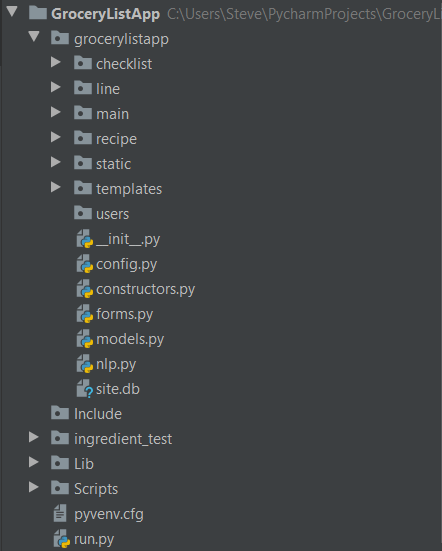It’s almost time to implement the final area of my Grocery App – the ability to create an account and save your lists there. However, before I take this step, I wanted to take a day or two to prep my code for this, and to figure out how I could refactor it into something that will better handle the additional complexity. After all, my routes.py file has been getting very long, and while I wouldn’t quite call my code “spaghetti” (I hope not, at least), I was beginning to feel as though it was growing a bit to big for its shell.
It was time to split things up.
After some thought about how best to do so, I decided to split my routes into five different blueprints:
- the
mainblueprint, which would currently only include the homepage, but later might include an “About” page or other pages that lack a specific association with a grocery list, - a
checklistblueprint, which would hold all the routes associated with theCompiledListmodel, such as the main list page and the routes to delete and rename a list, - a
lineblueprint, which would hold all the routs associated with a specific line, either aCleanedLineor aRawLine. At some point in the future, I might break up these two line types, - a
recipeblueprint, which would hold all the routes associated with a specific recipe, namely the “Add Recipe” page, - a
usersblueprint, which will hold all the routes associated with the users.
With this general skeleton in mind, I got to work. I’m pleased to say that most of my code separated fairly easily, which I’m hoping is a sign that I generally wrote it well. There were a few areas, however, that stayed tangled, and after some thought I had to check myself and think about why and how I was splitting it up the way I was. In particular, many of the functions in utils.py were being used by more than one separated route. At first, I got around this by using POST redirects, such as on my homepage:
<form method="POST" action="{{url_for('checklist.create', method='url')}}">
...
<form method="POST" action="{{url_for('checklist.create', method='manual')}}">… and then directing them to a new route, which effectively ran the same code that the main.home route ran on its respective calls to validate_on_submit():
@checklist.route('/list/create/<string:method>', methods=['POST'])
def create(method):
new_list = create_list()
# figure out how the list was created
print(request.form)
if method == 'blank':
return redirect(url_for('checklist.compiled_list', hex_name=new_list.hex_name))
elif method == 'url':
# take the url input and parse for ingredient lines
new_recipe = create_recipe_from_url(request.form.get('url-url', '', type=str))
new_recipe.complist = new_list
elif method == 'manual':
new_recipe = create_recipe_from_text('Untitled Recipe', request.form.get('custom-recipe_lines', '', type=str))
new_recipe.complist = new_list
else:
abort(404)
return redirect(url_for('recipe.clean_recipe', list_name=new_list.hex_name, new_recipe=new_recipe.hex_name))At first, this struck me as a fairly elegant solution, since I could simply redirect the necessary logic between routes and keep everything nicely separated. However, I soon realized that doing so would lead to two problems:
- It encouraged a lot of redirects, and
- (more importantly) often the POST data that the forms provided involved more than one “area,” resulting in a situation where keeping helper functions in one package excluded them from another package. I could get around this by importing from another package, but that kind of defeated the purpose of having different packages in the first place.
This, plus the fact that, when I looked online I couldn’t really see any examples of someone using Flask this way, made me paranoid that I was abandoning best practices, so I hit the brakes on this method.
After some more thought, it seemed to me that I was following the letter of the law too closely and ignoring the spirit of the thing. In the name of perfect organization and modularity, I was overcomplicating my code. And besides, there isn’t any law that states that helper functions need to be associated with only a single blueprint. I decided instead to take the helper functions that needed to be accessed in more than one place and put them in the main package instead. I created a constructors.py module for functions associated with building RecipeLists and CompiledLists, and created an nlp.py module for any function that deals with spaCy model. Other helper functions that only concerned one blueprint were put into a utils.py folder unique to that blueprint. I ended up with this file structure:

It took a little while to go through and make sure everything was linked up properly, but I’m pleased with the result. I suspect that my code still needs additional refactoring, but I plan to do another, more intensive pass after implementing the user features; this was more to clear the way for those additions. My hope is that, once this is feature complete, I can go through and smooth over some areas that are still kind of rocky.
One final note before I close this out: halfway through refactoring this I realized how nice it would be if I’d implemented version control. I’d been meaning to get this app on github for a while, but this finally pushed me over the edge. You can see it here, and I’ll be updating it as I go.
Next Steps:
- add users (it’s a big one)